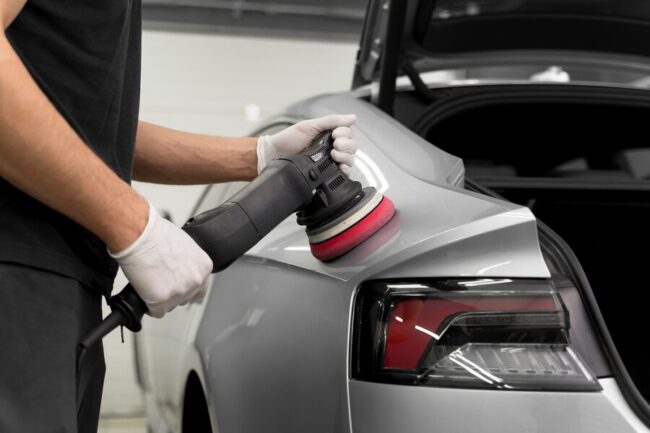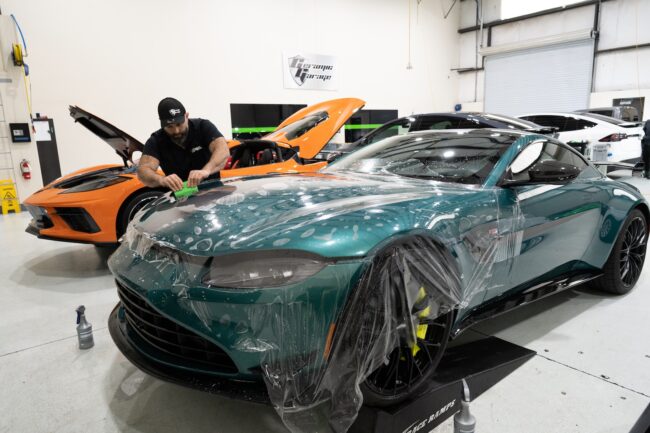In the realm of high-performance applications, where durability and resilience are paramount, ceramic coating emerges as a transformative solution that transcends its conventional automotive roots. While the automotive industry has long benefited from the protective and aesthetic qualities of ceramic coatings, the material’s potential extends far beyond the glossy finishes of sports cars and luxury vehicles. This advanced coating technology has found its way into various high-performance sectors, ranging from aerospace to industrial machinery, redefining the standards for surface protection and performance optimization.
The inherent properties of ceramic coatings, such as resistance to extreme temperatures, corrosion, and wear, position them as indispensable assets in environments where robust protection is non-negotiable. This blog explores the diverse applications of ceramic coatings beyond the automotive sector, delving into their role in safeguarding critical components of high-performance machinery, enhancing efficiency, and contributing to the longevity of equipment in demanding operational conditions. As we navigate through the multifaceted landscape of ceramic coatings, it becomes evident that their transformative impact extends well beyond the automotive industry, shaping the future of performance-driven applications across various sectors.
Aerospace Advancements
In the dynamic realm of aerospace engineering, where cutting-edge technology and reliability are non-negotiable, ceramic coatings have emerged as pivotal components in shaping the future of aircraft. These coatings, known for their remarkable resistance to extreme temperatures and harsh environmental conditions, play a crucial role in enhancing the durability and performance of aircraft components. From turbine blades to engine exhausts, ceramic coatings act as a protective shield against the corrosive effects of high-altitude flights, ensuring optimal functionality and safety.
Aerospace engineers leverage the unique properties of ceramic coatings to reduce wear and tear on critical components, thereby extending the lifespan of crucial aircraft parts. The thermal insulation capabilities of ceramics also contribute to improved fuel efficiency, a critical factor in an industry constantly striving for enhanced sustainability. This blog segment delves into the specific applications of ceramic coatings within the aerospace sector, shedding light on how these innovations propel aviation technology to new heights, fostering reliability, efficiency, and the overall advancement of air travel.
Industrial Machinery Revolution
In the ever-evolving landscape of industrial machinery, a revolution is underway, fueled by the transformative capabilities of ceramic coatings. These coatings, originally celebrated for their role in automotive aesthetics, have found a new frontier within industrial settings, promising unparalleled protection and longevity for critical machinery components. The industrial machinery revolution driven by ceramic coatings is marked by a profound impact on performance, maintenance, and overall operational efficiency.
 Wear Resistance: Ceramic coatings provide an exceptional defense against wear and abrasion, ensuring prolonged life for gears, shafts, and other crucial components.
Wear Resistance: Ceramic coatings provide an exceptional defense against wear and abrasion, ensuring prolonged life for gears, shafts, and other crucial components.- Corrosion Protection: In corrosive industrial environments, ceramic coatings act as a formidable barrier, safeguarding machinery from degradation caused by chemical exposure.
- Increased Efficiency: Reduced friction and improved lubrication enhance the overall efficiency of industrial machinery, resulting in optimized performance and reduced energy consumption.
- Temperature Regulation: The ability of ceramic coatings to withstand extreme temperatures makes them invaluable in environments where machinery is subjected to thermal stress, contributing to consistent and reliable operation.
- Maintenance Cost Reduction: By minimizing wear and corrosion, ceramic coatings lead to decreased maintenance needs, translating to significant cost savings for industrial enterprises.
As industries embrace this technological revolution, the adoption of ceramic coatings in industrial machinery underscores a paradigm shift towards sustainability, reliability, and enhanced productivity.
Beyond The Paint Job
The conventional notion of ceramic coatings often revolves around their role in providing a glossy finish to automobiles. However, when we delve deeper, it becomes evident that their impact transcends the superficial aesthetics of a paint job. In high-performance environments, these coatings play a pivotal role in enhancing functional excellence and overall surface performance. Ceramic coatings, renowned for their exceptional hardness and durability, go beyond mere visual appeal to offer a robust shield against a myriad of environmental stressors.
In applications ranging from aerospace to industrial machinery, ceramic coatings serve as guardians of critical surfaces, defending against corrosion, abrasion, and extreme temperatures. The intricate chemistry behind these coatings allows for a molecular bond that transforms surfaces into resilient fortresses, extending the lifespan of components and machinery. This exploration delves into the diverse functional aspects of ceramic coatings, unveiling their transformative role in ensuring high-performance surfaces withstand the rigors of various industries, ultimately contributing to increased efficiency, reduced maintenance costs, and unparalleled longevity.
Extreme Temperature Resistance
In the world of high-performance applications, with environments subject to extreme temperatures, the importance of materials that can withstand thermal stress cannot be overstated. Ceramic coatings emerge as champions in this domain, showcasing remarkable resistance to temperature extremes. These coatings, often formulated with advanced ceramic nanoparticles, create a robust thermal barrier, offering protection against both intense heat and chilling cold. This capability makes them invaluable in industries where temperature variations are the norm, such as aerospace, industrial machinery, and energy production.
- High Heat Tolerance: Withstanding temperatures well beyond conventional coatings, ceramic coatings excel in environments with elevated heat levels.
- Thermal Insulation: Providing effective insulation against heat transfer, preventing damage to underlying surfaces.
- Cold Endurance: Maintaining structural integrity and functionality even in sub-zero conditions.
- Consistent Performance: Ensuring stability and reliability in the face of fluctuating temperatures.
- Reduced Thermal Stress: Minimizing the impact of thermal expansion and contraction on coated components.
- Applications in Space Exploration: Playing a crucial role in protecting spacecraft and equipment from the harsh conditions of outer space.
Energy Sector Solutions
In the dynamic landscape of the energy sector, where harsh operational conditions and corrosion pose significant challenges, ceramic coatings emerge as a groundbreaking solution. These coatings play a vital role in safeguarding critical components within the energy industry, contributing to the overall efficiency and longevity of infrastructure.
- Oil and Gas Exploration: Ceramic coatings act as a formidable defense against corrosive elements, protecting pipelines, valves, and drilling equipment from degradation in oil and gas extraction operations.
- Power Generation Plants: High-temperature resistance makes ceramic coatings ideal for application in power plants, ensuring longevity and reliability in the face of extreme heat and thermal cycling.
- Renewable Energy Infrastructure: Solar panels and wind turbine components benefit from ceramic coatings, providing protection against environmental elements and enhancing the performance of renewable energy systems.
- Corrosion Resistance: Ceramic coatings create a durable barrier against corrosive substances, preventing degradation of crucial components.
- Thermal Stability: Withstand extreme temperatures, ensuring operational reliability in energy production processes.
- Reduced Maintenance Costs: Enhanced durability minimizes the need for frequent maintenance, resulting in cost savings for energy companies.
In the energy sector, ceramic coatings stand as a formidable ally, addressing the unique challenges posed by the industry’s demanding operational environments and contributing to sustainable and efficient energy production.
Electronic Devices And Components
In the dynamic landscape of electronic devices and components, where miniaturization and precision are paramount, ceramic coatings emerge as silent guardians, ensuring the longevity and reliability of intricate technologies. Beyond the sleek exteriors of our smartphones and gadgets lies a world where ceramic coatings play a pivotal role in safeguarding the delicate components that power our digital lives. The unique properties of ceramic coatings, including thermal resistance, hardness, and resistance to chemical exposure, make them indispensable in this realm of microelectronics.
 Thermal Management: Ceramic coatings dissipate heat effectively, preventing thermal buildup that can compromise electronic components’ performance.
Thermal Management: Ceramic coatings dissipate heat effectively, preventing thermal buildup that can compromise electronic components’ performance.- Protection Against Corrosion: In the corrosive environment of electronic devices, ceramic coatings act as a barrier, shielding sensitive circuits and connectors from damage.
- Enhanced Durability: The hardness of ceramic coatings ensures resistance to scratches, abrasions, and wear, extending the lifespan of electronic components.
- Dielectric Properties: Ceramic coatings offer excellent dielectric strength, crucial for insulating and protecting delicate electronic circuits from electrical interference.
- Miniaturization Support: As devices shrink in size, ceramic coatings provide a thin yet robust layer of protection, maintaining functionality in increasingly compact designs.
In the intricate world of electronics, ceramic coatings silently contribute to the reliability and longevity of our gadgets, ensuring that the microcosm of electronic components remains resilient in the face of daily use and environmental challenges.
Medical Equipment Innovation
In the dynamic landscape of healthcare, the integration of ceramic coatings represents a groundbreaking frontier in medical equipment innovation. Beyond the sterile white surfaces of medical devices lies a realm where ceramic coatings play a vital role in ensuring the longevity, safety, and efficiency of critical equipment. These coatings, characterized by their biocompatibility and resistance to corrosion, introduce a new era in medical technology, fostering advancements that extend far beyond traditional norms.
- Biocompatibility: Ensures compatibility with biological systems, reducing risks of adverse reactions.
- Corrosion Resistance: Protects sensitive medical instruments from corrosion caused by various chemicals and bodily fluids.
- Wear Resistance: Enhances the durability of moving parts, extending the lifespan of equipment.
- Easy Sterilization: Facilitates easy and effective sterilization procedures, maintaining aseptic conditions.
- Improved Imaging Devices: Enhances the performance of imaging equipment, providing clearer and more accurate results.
As the medical field continually embraces technological progress, ceramic coatings stand at the forefront, safeguarding the reliability and efficacy of crucial medical instruments while contributing to the overall advancement of healthcare technologies.
In concluding our exploration into the diverse applications of ceramic coatings, it’s evident that these innovations extend far beyond automotive allure. From aerospace to medical realms, ceramic coatings redefine durability, protection, and efficiency in high-performance sectors. As we acknowledge their transformative impact, it’s essential to consider the practical implementation in your specific domain. For inquiries or to embark on the journey of enhancing your surfaces, reach out to Quality Auto Glass & Tint at 4500 Salida Boulevard, Suite D-E, Modesto, CA, 95368, or contact them at (209) 900-8269 or Support@qualityautoglasstint.com. Open Monday to Saturday from 9 am to 5 pm, let the experts guide you towards a future where resilience meets innovation. Elevate your surfaces; embrace ceramic excellence today.




